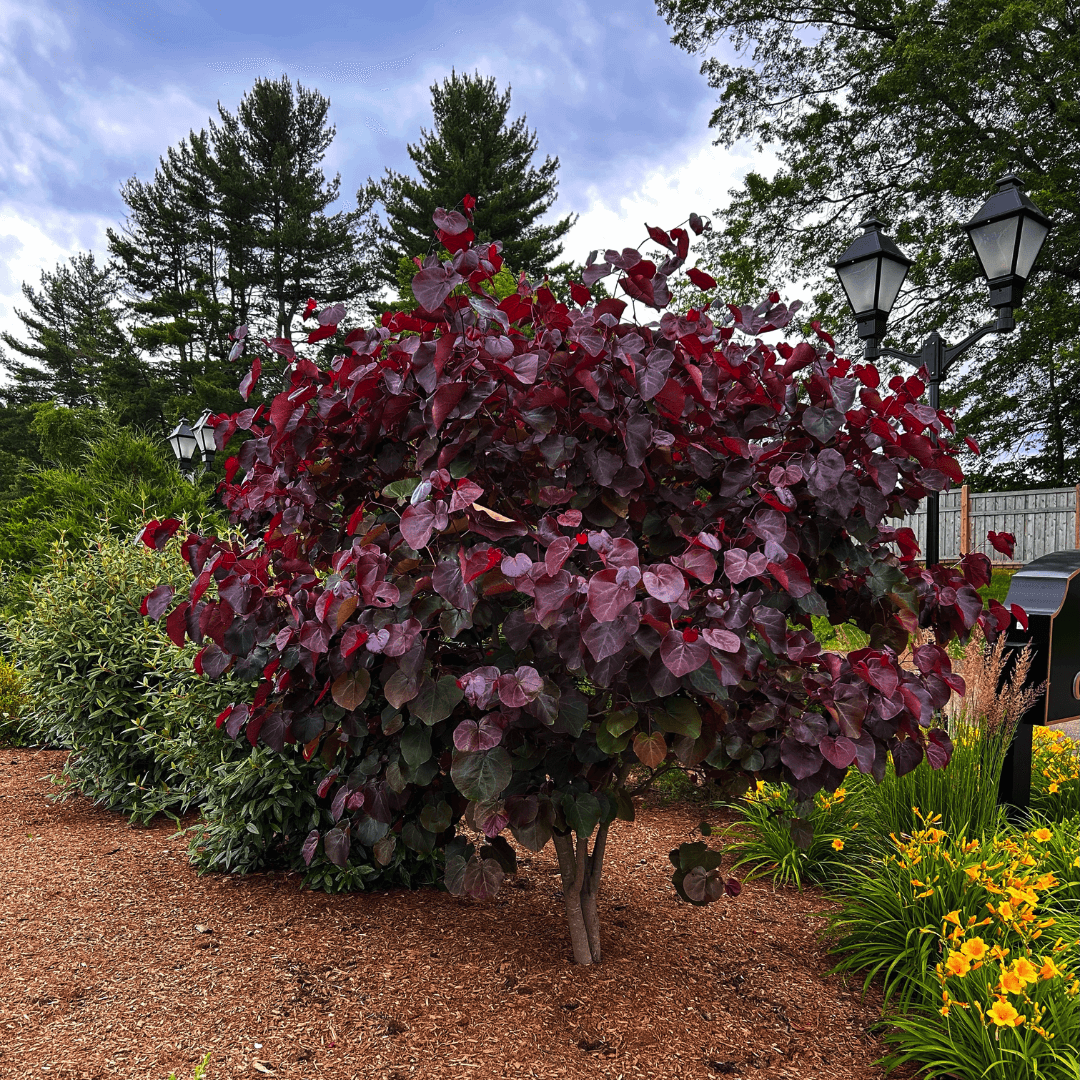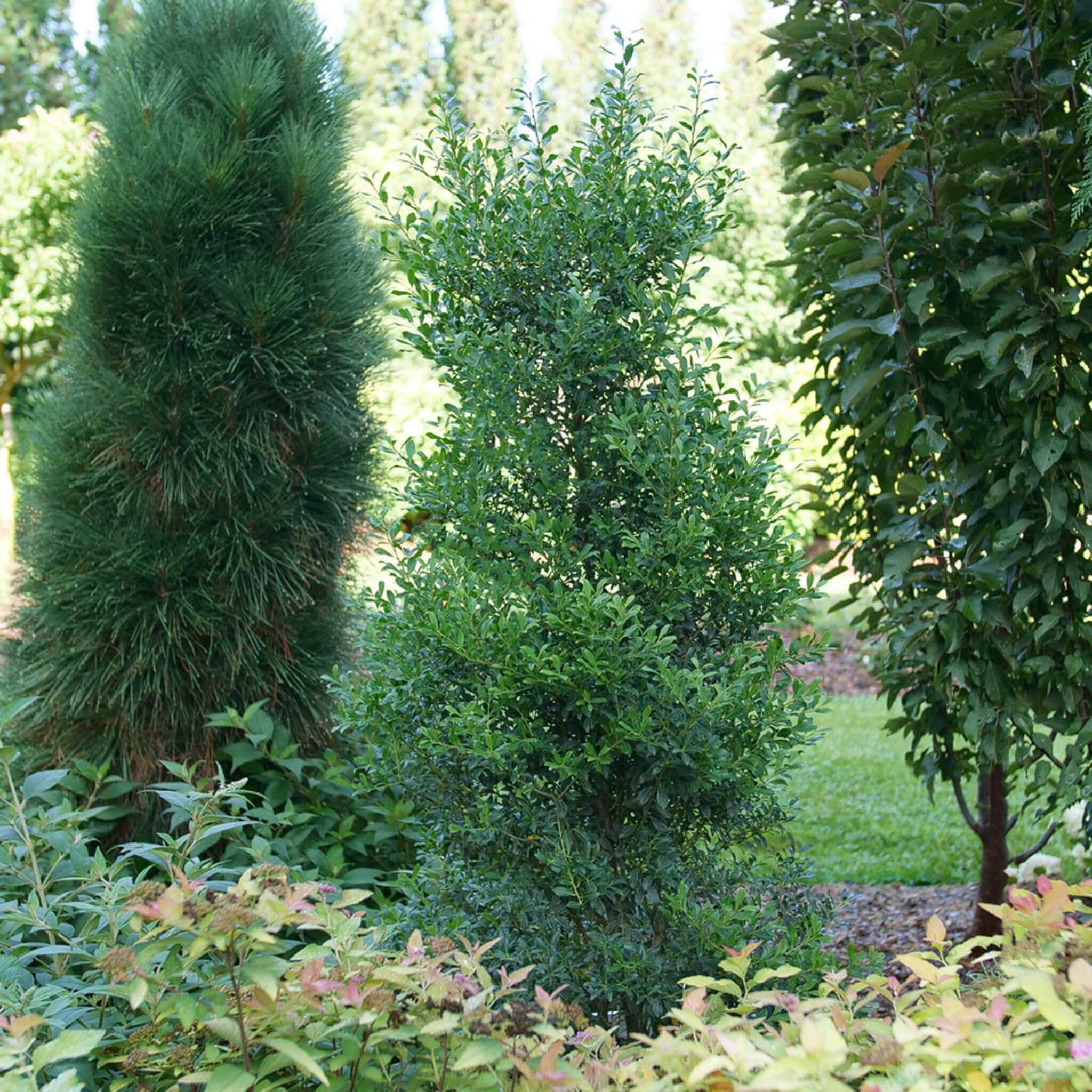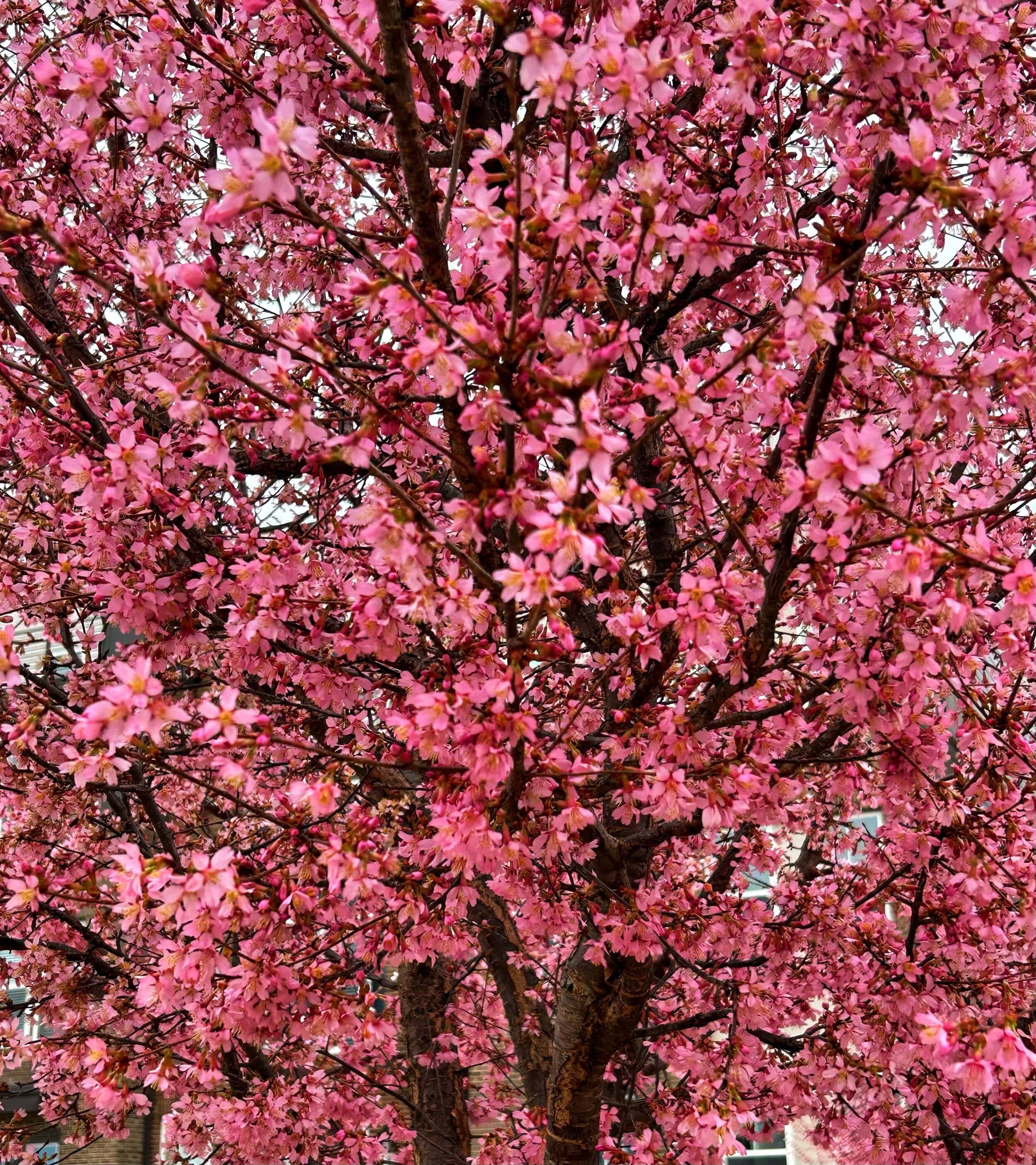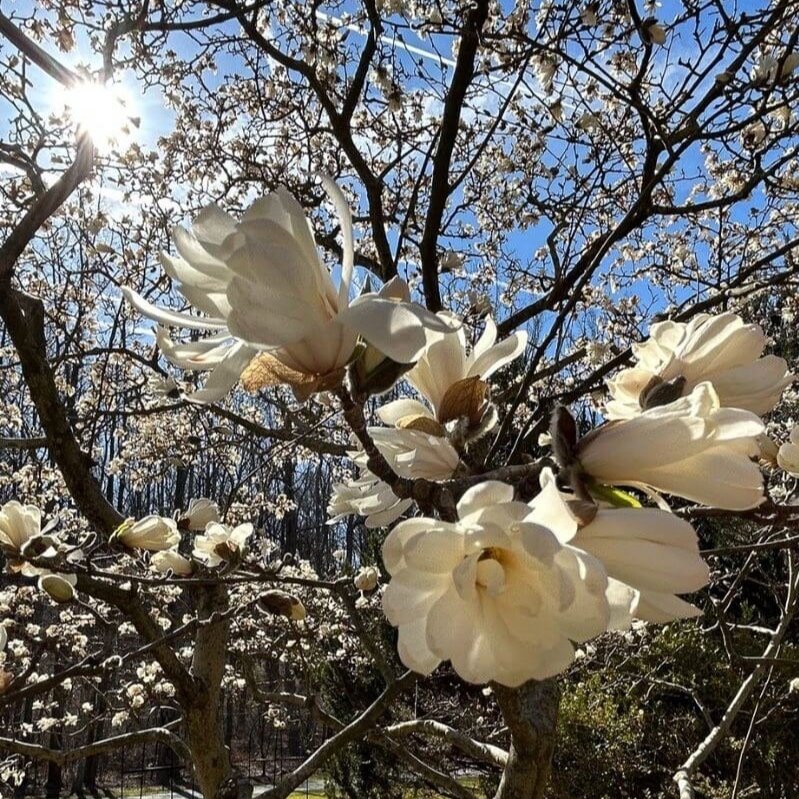The Heat and Drought Tolerant Merlot Redbud Tree
A Redbud Tree with Red Leaves
This small flowering tree is perfect for smaller yards and landscapes.
When it comes to adding beauty and elegance to your garden, few trees can match the charm of the Merlot redbud (Cercis 'Merlot').
With its stunning burgundy foliage, delicate pink spring flowers, and a graceful branching structure, this small spring flowering tree is a showstopper in any landscape, and the perfect size for smaller space gardens.
Merlot redbud is a hybrid cultivar of the ‘Forest Pansy’ and ‘Texas White’ redbuds. Unlike other redbuds, the Merlot cultivar has the ability to thrive in heat and drought.
This tree’s unique hybrid genetics blend the purple-leaved beauty of its ‘Forest Pansy’ parent with the heat tolerance of its Texas redbud parent, creating a tree that thrives in high temperatures and dry soils.
In spring, lavender pink flowers appear before the leaves open up, attracting pollinators and bringing a splash of color to the early spring landscape.
Flowers are followed by thick heart-shaped red leaves the color of a deep red Bordeaux wine, turning deeper shades of purple as fall approaches.
The foliage holds its color all season long, and the leaves don’t burn and look ragged in summer heat. Merlot redbud has far fewer seedpods than other redbud cultivars.
Merlot redbud grows in full sun to partial shade, in zones 6-9. It grows at a moderate rate (13-24 inches per year), eventually reaching a mature height of 9-12 feet tall and 12-15 feet wide.
Choose a location in your garden that receives at least 6 hours of direct sunlight per day, and ensure the soil is well-draining.
And yes, this plant is drought tolerant, but that does not mean it’s okay to forgo watering entirely and ignore your tree! It still needs deep waterings for at least 2 years after planting, and during extended dry spells.
The Merlot redbud tree branches low to the ground.
Merlot Redbud Care
Location: Select a location with well-draining soil and partial shade to full sun exposure. Redbuds in general require moist, well-draining soil and tolerate a wide range of soil types, including acidic, alkaline and clay. Merlot redbud can handle drier conditions than the straight species.
Planting time: The best time of year to plant a redbud tree is in the spring or fall, giving the roots time to establish before the onset of extreme hot or cold weather. Water the tree deeply after planting.
Mulch: Apply a layer of mulch around the base of the tree to help retain moisture, suppress weeds, and regulate the soil temperature. Make sure the mulch does not touch the base of the tree; avoid creating a “mulch volcano”.
Watering: Water the newly planted tree regularly and deeply, especially during hot and dry periods. Keep the soil consistently moist but not waterlogged. Once established, Merlot redbuds are considered drought tolerant but will still benefit from occasional deep waterings. Are you in a drought? Check the U.S. Drought Monitor.
Pruning and fertilizing: The Merlot redbud tree will naturally grow into a beautiful shape and requires little pruning - remove any dead or damaged branches as needed. If desired, prune and shape in late winter while the tree is dormant. Redbuds do not require fertilizing but can benefit from an annual application of fertilizer, depending on the site. Protect your investment and consider developing a routine of hiring an arborist who can expertly handle fertilization and pruning, provide proactive care, and address potential issues promptly.
Diseases: Keep an eye out for diseases that may affect the Merlot redbud, such as canker and leaf spot. Proper cultural practices, including adequate moisture, can help to prevent issues from occurring.
How Big Does a Merlot Redbud Get?
The Merlot redbud grows at a moderate rate, adding 13-24 inches per year under ideal conditions, until it reaches a mature size of 9-12 feet tall and 12-15 feet wide.
It naturally grows in a graceful, compact, rounded shape and does not require pruning. The Merlot redbud has a low branching habit, with branches growing close to the ground rather than having a tall, bare trunk before branches begin.
This small size and compact shape of the Merlot redbud makes it an ideal choice for small space gardens and landscapes. It fits comfortably into small yards where larger trees would be overwhelming and impractical.
Whether used as a focal point in a courtyard, near a patio, or as part of a mixed border, the Merlot redbud brings vibrant color and texture without dominating the space.
Its petite stature and controlled growth also mean it won't encroach on nearby plants or structures, making it perfect for urban gardens or any setting where space is at a premium.
Spring beauty on full display: this Merlot redbud tree is ready to burst into bloom.
Where to Plant Merlot Redbud:
Plant Merlot redbud as an accent or single specimen tree, in a place where the spring flowers and deep burgundy leaves can be appreciated.
The small size and upright vase-shape makes Merlot redbud the perfect addition to any mixed border or mixed privacy screen. Or, plant this small tree at the edge of a woodland or in a pollinator garden.
Use the dark burgundy leaves of Merlot redbud as a backdrop for brightly colored shrubs and perennials. Plant along the edges of the landscape to make unwanted views of sheds, fences, and trash cans recede into the background.
Planting Companions for Merlot Redbud
For a romantic, colorful look in the landscape, plant Merlot redbud with masses of pink ground cover roses (like Rosa ‘Meifranjin’ Blushing Drift®) and nepeta.
For larger yards and landscapes, make a bold statement and mass Merlot redbud trees with other spring-blooming trees like serviceberries (Amelanchier species), Little Girl magnolias, and Okame cherry trees.
For an easy, low-maintenance garden bed, plant Merlot redbud with creeping lilyturf (Liriope spicata) and astilbes.
For a no-prune garden bed, plant Merlot redbud with the evergreen, extremely low-maintenance shrub dwarf Japanese cedar.
This is a very low-branching tree, so be sure to space companion plants at least 2 feet from the trunk. Also, be sure to plan for the mature size of 9-12’ high and 12-15’ wide, and your future self will thank you!
How Often Should I Water Merlot Redbud?
Proper watering is essential to keep your tree healthy. Merlot redbuds will need supplemental watering during the first two years after planting, and during times of drought.
But wait, isn’t Merlot redbud drought resistant? Yes, to an extent - it stands up to heat and drought better than other types of redbuds, but that does not mean it’s okay to forgo watering and ignore your tree. You paid lots of money for this tree, and you want it to thrive - not merely survive!
The watering requirements for a tree can vary significantly depending on several factors, and there is no one-size-fits-all prescription. This absence of a universal watering guideline can be exasperating for gardeners!
Being attentive to your trees and the environmental factors that impact them will enable you to adjust your watering schedule accordingly, ultimately promoting healthier growth and overall success.
Planting a tree is an investment - learn how to protect your investment with proper watering in our article “How to Water a Tree”.
Does the Merlot Redbud Tree Need Pruning?
Merlot redbuds are small, compact trees that do not need regular pruning. Prune out dead or crossed branches as needed. After 3-5 years, an occasional pruning may be beneficial to shape the tree and encourage proper air circulation - enlist the help of a skilled arborist if needed.
Prune your redbud when the tree is dormant, during late winter to early spring. This minimizes stress on the tree and reduces the risk of disease. Use sharp and clean pruning tools to make precise cuts. Pruning shears are suitable for small branches, while loppers or a pruning saw may be necessary for larger branches.
Remove any dead, diseased, or damaged branches. Look for branches that cross each other or grow inward, and cut these off as well. Crossed branches can rub together on windy days, scraping off the bark and making the tree vulnerable to disease.
If you're uncertain where to prune your tree, or you are dealing with larger branches, it's a good idea to consult with a local skilled arborist for guidance.
Merlot Redbud vs Forest Pansy
Keep scrolling for a side-by-side photo comparison!
Size
Merlot Redbud: Reaches 9-12 feet tall and 12-15 feet in width; compact and small, ideal for small spaces.
Forest Pansy Redbud: Grows to 20-30 feet high and 25-35 feet wide; larger and suitable for more expansive landscapes.
Form
Merlot Redbud: Rounded, compact canopy with low branching; dense and uniform shape.
Forest Pansy Redbud: Broadly spreading with a vase-like shape; often more open and airy.
Leaf Color
Merlot Redbud: Rich, wine-red foliage in spring and summer turns deep purple in fall.
Forest Pansy Redbud: Deep purple leaves in spring and summer, turning brilliant purple, deep red and orange in fall.
Flower Color
Merlot Redbud: Bright pink-magenta flowers that appear in early spring before the leaves emerge.
Forest Pansy Redbud: Similar pink-magenta flowers, blooming in early spring with a slightly more muted tone.
Cultural Requirements
Merlot Redbud: Thrives in full sun to partial shade; prefers well-drained soil and is more drought-tolerant than other redbuds.
Forest Pansy Redbud: Also thrives in full sun to partial shade but prefers consistently moist, well-drained soil and can be more susceptible to drought stress.
Find a Tree for Your Landscape:























Create a Winter Wonderland with This Unique Small Tree